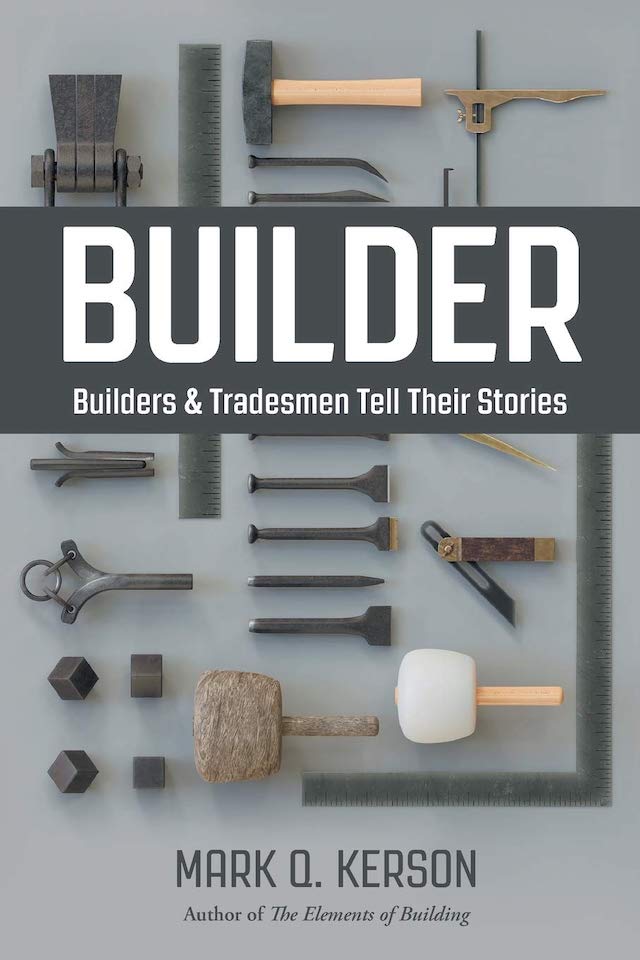BUILDER
BUILDER: Builders & Tradesmen Tell Their StoriesMark Q. KersonFrom The Ground Up Publishing, December 2020Paperback | 6 x 9 inches | 386 pages | English | ISBN: 978-0991327713 | $27.00PUBLISHER'S DESCRIPTION:BUILDER is a gathering of insights and the telling of tales from residential builders. It offers guiding principles, lessons learned, and a glimpse into why we take up a trade, and why so many of us are passionate about what we do. Its purpose, apart from telling these wonderful stories, is to help you navigate the process of opening and growing a company, by listening in as builders explain what they wish they’d known, how they learned, and what they would have done differently.REFERRAL LINKS: dDAB COMMENTARY:Architecture is an infrequent subject of humor on The Simpsons. Most famously, one episode has Frank Gehry designing a concert hall for Springfield, a building Mr. Burns eventually buys and turns into a prison. Construction is the same. In another good episode, Ray Romano plays a roofer, Ray Magini, who befriends Homer at a bar and offers to help with his leaky roof. Ray starts on the roof but then fails to show on numerous occasions, leading the other Simpsons to think he is a figment of Homer's imagination. Near the end of the show, the family sees Ray is real. Marge asks him, "Why did you start fixing our roof and then just disappear?" He replies "That's easy, I'm a contractor!" Everybody laughs together and then Marge and Ray agree that all contractors are crooks.Are all contractors crooks? Of course not, but there is a little bit of truth in Ray Romano's caricature of a roofer, particularly in terms of how people perceive contractors: as unreliable, and as careless managers of their time. As an architect, I have an almost ingrained antagonism toward contractors, fostered in architecture school and its nonchalance toward construction, and strengthened in practice, when most of my construction administration experience dealt with pointing out the ways the contractor was departing from the specifications they bid on (my comments to them were rarely heeded). Given the importance of construction in the success of buildings, such antagonism is harmful — and increasingly outdated, as more and more design/build programs are offered in architecture schools, my alma mater included.Although the target audience for BUILDER, the followup to Mark Q. Kerson's The Elements of Building, are future contractors and tradespeople, some of the nearly 30 interviews should appeal to architects as well, particularly to architects who work on single-family houses in the United States. Most of the interviews are with general contractors, though there are also cabinet makers, an electrician, an automotive machinist, even a chimney sweep. Some highlights include Kerson's talk with Jesper Kruse of Maine Passive House, who might be the "greenest" guy in the book; his talk with Heather Thompson, one of the few women in the book (evidence of the field's gender slant, not Kerson's selection); his lengthy conversation with Sal Alfano, a longtime former editor of the Journal of Light Construction; and his talk Matt Risinger, who builds homes in Austin, Texas, but also has an immensely popular YouTube channel.Of these, Kruse and Risinger should be especially appealing to architects, since they share many of the concerns of architects: sustainable architecture and architecture-driven projects. Although it's clear Kerson visited his subjects in person, he has a number of set questions that appear throughout the book, some of them technical, many geared to business. Some questions touch on trade versus business skills. Kruse, for instance, treats each with similar principles — tidiness and precision, one on the job site, one in the books — while Risinger talks about the tension between the two, since he "love[s] being in the field" but needs to "be selling jobs and managing [his] company well." That most GCs start in the trade by learning how to build things, and then transition into business as owners and managers, gets at the joke that started this commentary: contractors aren't crooks, they're just skilled tradespeople trapped in the roles of managers.SPREADS:

Paperback | 6 x 9 inches | 386 pages | English | ISBN: 978-0991327713 | $27.00
PUBLISHER'S DESCRIPTION:
REFERRAL LINKS:
SPREADS:








